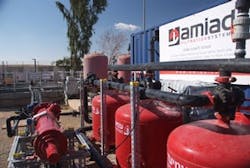Israel’s pioneers set out to make the desert bloom, and they have succeeded. Along the way, they have forged the gold standard for wastewater recycling—75% of the tiny nation’s wastewater is treated and reused. By comparison, the world’s No. 2 country for wastewater reuse is Spain, with 12%. The U.S. falls somewhere below 6%.
Israel’s aggressive wastewater treatment program allows the nation to consume 2 billion cu meters of water per year, though Mother Nature only delivers 1.3 billion in surface water and groundwater. Of that 1.3 billion cu meters of freshwater, 800,000 is earmarked for domestic use and 100 million goes to industry. An ambitious plan to produce 700 million cu meters of desalinated seawater each year to supply domestic needs advances Israel’s water technology even further.
Holistic View
Half of Israel’s irrigation water, about 500 million cu meters or 405,000 acre-ft per year, is treated wastewater. The country is woven tightly with purple pipes, transporting wastewater from bustling cities to faraway farms. The Israel Water Authority’s pricing makes treated wastewater attractive—the cost to farmers is about one-fourth the price of freshwater—but so does the wastewater’s reliability, which is in far steadier supply than rainfall in the desert.
The nation’s dependence upon treated wastewater for its food supply and valuable export commodities creates a holistic view of water quality from its first use to its last.
“Among the brilliant approaches to water reuse that have taken hold in Israel is the strategy of treating water according to its intended use,” said Jim Lauria, vice president of sales and marketing for Amiad Filtration Systems in Oxnard, Calif. “Desalinated seawater, which is an expensive gallon of water, is directed to domestic use. Wastewater may undergo secondary or tertiary treatment, depending on the crops and application techniques where it will be used. That improves the efficiency of the whole process. Water is treated to meet the needs at hand, and not over-treated, which would burn up excess energy and increase the environmental footprint of the process.”
Lauria pointed to a pair of wastewater treatment plants in the Negev Desert, just a few miles from each other, to illustrate.
Beersheva Wastewater Treatment Plant
The city of Beersheva’s new wastewater treatment plant turns the effluent of the bustling city—population around 200,000—into irrigation water that matches the quality of local well water and supports the area’s potato and onion fields. At a capacity of 3,000 cu meters per hour (13,200 gal per minute), it is Israel’s third-largest wastewater treatment plant.
It is also home to a pilot test of an innovative tertiary treatment system. To meet the demands of the European market, where much of the produce will be sold, the water is being disinfected with UV rather than chlorine before it is injected through drip irrigation tubes deep below the crop.
To prepare the water for efficient UV disinfection, the flow is directed from the primary clarifier through 25-micron Amiad SAF automatic self-cleaning screen filters , then through a 7-micron Amiad automatic micro fiber (AMF) filter .
Both types of filters initiate cleaning cycles automatically when a set pressure differential is reached between the dirty and clean sides of the filter. That allows the system to adjust to the large fluctuations in influent water quality at the facility.
In the case of the screen filters, a flush valve opens to atmospheric pressure, causing water to flow through nozzles that direct its force through a square inch of screen at a time, dislodging the filter cake. The nozzles scan the screen in a spiral pattern, cleaning its entire surface without interfering with the filtration process.
AMF filters use a highly focused stream of water to remove trapped particles from the polyester thread tightly wound around plastic cores to form dozens of cassettes inside the filter housing. The jet of water is deflected by grooves in the core, passing through the fibers and removing the solids.
At the Beersheva plant, water enters the filtration system with a total suspended solids (TSS) concentration as high as 20 mg/L. Removing the vast majority of the solids helps make the UV process more efficient and effective by minimizing particles that can scatter or absorb germicidal wavelengths, foul lenses and shield microbes.
Village of Lehavim
Along a stretch of Negev Desert highway, the village of Lehavim operates a small treatment plant to recycle the wastewater produced by the 5,000 residents of the town. An 80-micron Amiad SAF automatic self-cleaning screen filter is followed by an injection of alum, an 88-in. sand media filter and chlorination. In all, the plant operates at 100 to 150 cu meters per hour (440 to 660 gal per minute).
Water enters the treatment system at 25 mg/L TSS and exits at 2 mg/L. Treated water is stored in a buffered reservoir next to the plant and directed back to Lehavim at night, where it is applied via buried drip lines to public parkland. The combination of nighttime application and subsurface placement minimizes the chance of contact between residents and the treated wastewater, per Israeli regulations.
“Whether it’s recycling Lehavim’s wastewater to beautify the local parks or reusing Beersheva’s water to nourish the Negev’s agriculture industry, Israel sets a high standard for water management,” Lauria said. “Israel is truly renewing its most precious renewable resource, and as a result is improving the economy and the standard of living in a very arid land. The wastewater treatment sector alone ties together the best in water filtration and disinfection technology, water planning and management, drip irrigation and even aquifer storage and recovery at some plants.
“Around the world, even in areas with greater rainfall, water is becoming increasingly scarce, and so is the energy required to manage it. We all need to learn from Israel’s example and use 21st-century thinking and 21st-century technology to tackle 21st-century water challenges. Israel shows us what those challenges will look like—and what solutions will look like, too.”

